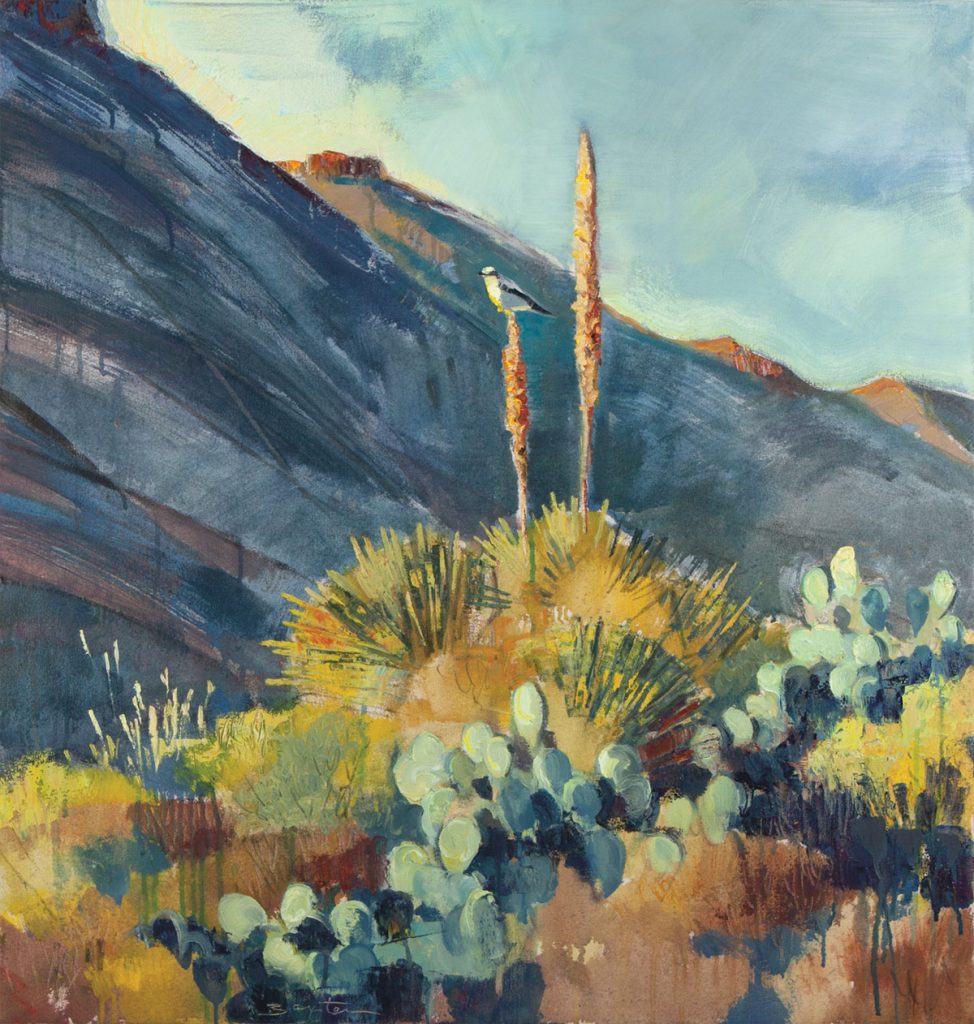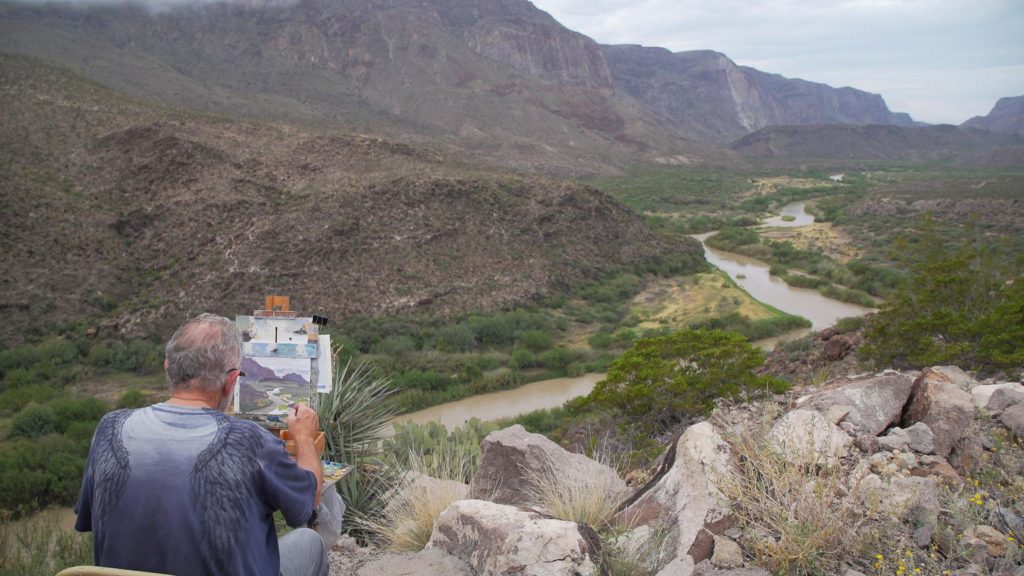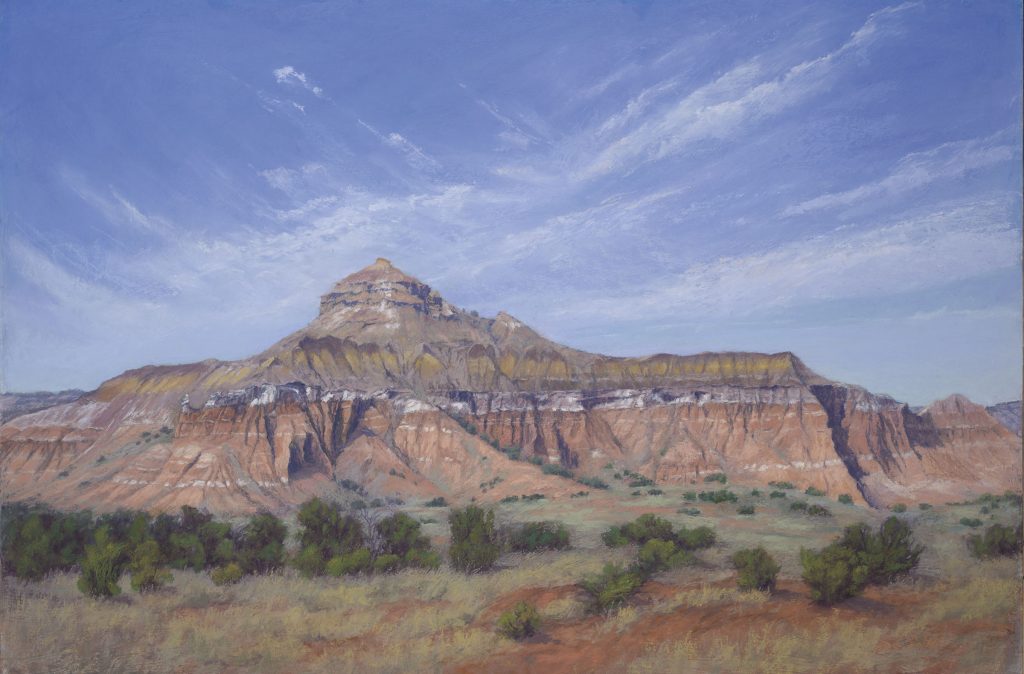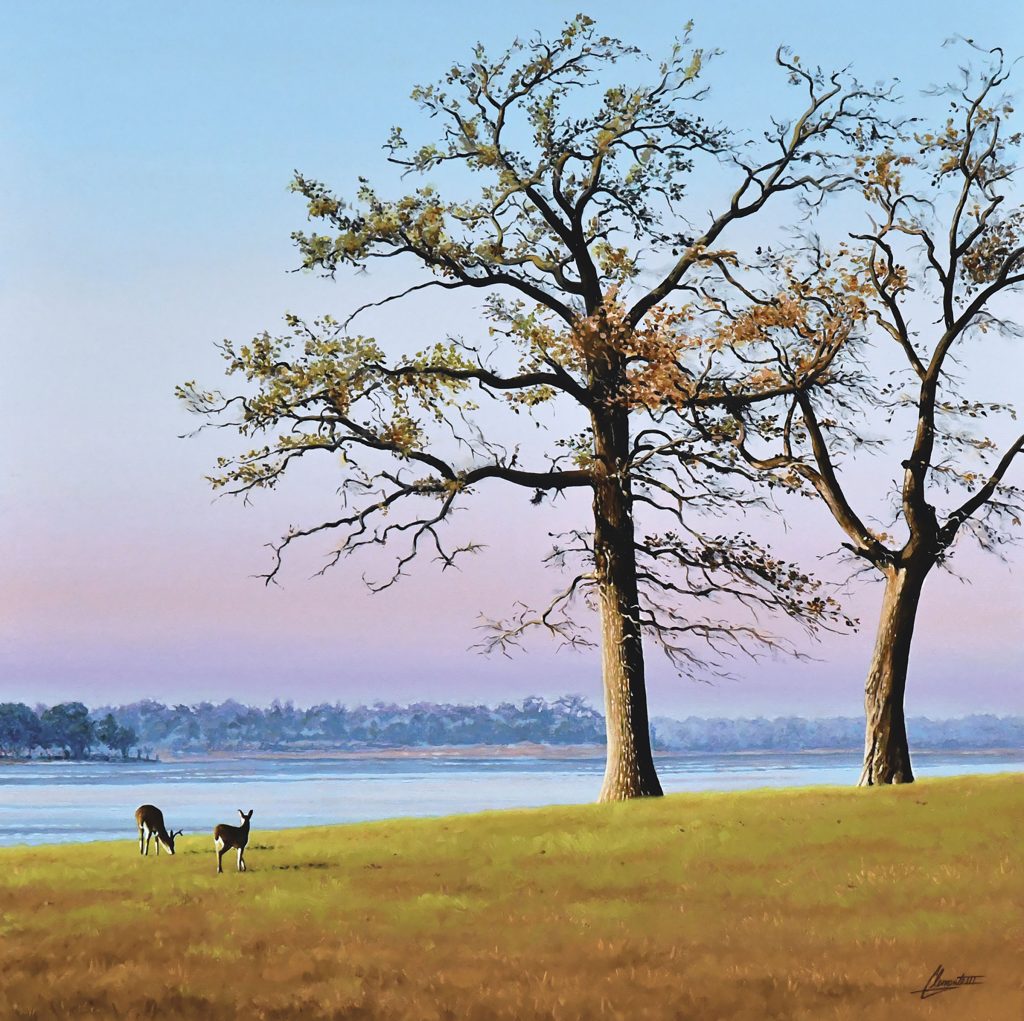
Butcherbird, Chinati Mountains State Natural Area by Mary Baxter. Photo courtesy Texas A&M Press
Pat Neff, the Texas governor who launched the state park system in 1923, described natural places as “breathing spots for humanity.” In speeches, he praised the health and happiness proffered by Texas’ “blue-bonneted hills” and “daisy-decked meadows.”
With a booming population that has increased six-fold since Neff’s day, Texas needs those breathing spots more than ever. To celebrate 100 years of the system that protects many of Neff’s beloved hills and meadows, conservationist Andrew Sansom and author Linda J. Reaves, in collaboration with the Texas Parks and Wildlife Department, have produced The Art of Texas State Parks, a Centennial Celebration, 1923-2023.
Published by Texas A&M University Press, the book is a zinger of an undertaking. Sansom, who founded The Meadows Center for Water and the Environment at Texas State University, and Reaves commissioned 30 of Texas’ top contemporary regionalist artists to paint 100 renderings of state parks. Sales of the book, which features 64 of the paintings, benefit the Texas Parks and Wildlife Foundation, the department’s nonprofit fundraising partner. In addition, the 30 “centennial artists” have each donated one painting for auction, with proceeds also going to the foundation.
A turn through the book’s more than 200 art-filled pages is a sensory ride through the immensity of Texas state parks, which are visited by more than 10 million people per year. The artistic depictions salute the parks in all their vivid beauty and diversity—from the illuminated canyons of Big Bend Ranch, to the lily pads and alligators of Caddo Lake, to the patterns of ripples across Purtis Creek. Gov. Neff would be proud.
“What’s so great about this book is that it really tells the story of our state parks through art,” says Aaron Friar, chief of staff at Texas Parks and Wildlife Department. “We see how beautiful our state parks are through another lens; we get a fresh perspective on just how much they are true gems we have to steward.”
In both style and subject, the paintings in the book are as varied as the parks they portray. Painter Margie Crisp’s acrylic on board rendering of a wild turkey in the Llano River—Handsome Tom, South Llano River State Park—highlights the challenge of managing natural places in the midst of flooding and invasive species. Mary Baxter’s oil on canvas painting of a loggerhead shrike bird perched atop a sunlit sotol cactus—Butcherbird, Chinati Mountains State Natural Area—is a preview of what awaits when the Chinati Mountains State Natural Area eventually opens in West Texas. (Park planning and development are under way; no opening date is set as of now). An egret flying downriver, the aged stone walls of a mission, water cascading over limestone… The book’s imagery is so appealing, it stirs up an irresistible urge to strap on some hiking boots and amble through a park.
Parks Art on Tour: Find The Art of Texas State Parks at booksellers and the Texas A&M University Press website. An exhibition of the Texas State Parks centennial artwork will travel to museums in 2023. The current schedule includes stops at: the Bullock Texas State History Museum in Austin, Jan. 7-April 30; Houston Museum of Natural Sciences, May 26-Aug. 4; and Panhandle Plains Historical Museum in Canyon, Oct. 14-March 25.

Courtesy Texas Parks and Wildlife
Drawing Texans to lesser-known parks is one aim of the project. “Some focus groups last year determined that there are many, many people in Texas who can’t even name a state park, and far fewer have visited one,” says Sansom, who was formerly the Texas state director of the Nature Conservancy and later executive director of Texas Parks and Wildlife. “And yet at the same time, there are some parks having to turn people away because they’re just in such high demand. There’s far more out there than just Enchanted Rock or Garner State Park, but many of these jewels are not well known. I hope this book will change that.”
While the art makes the book an aesthetic pleasure, the accompanying essays emphasize the evolution of our park system and what it needs to survive. Samson’s introductory essay explains just how much the park system was sculpted by historic events. Neff, for example, first decided to launch the Texas State Park Board when he saw how the spread of automobile travel in the 1920s created a need for affordable overnight stops for newly on-the-road Texans. Then came the Great Depression, which, ironically, was a boon for the parks. In their early years, parks received no funding from the Texas Legislature. The Civilian Conservation Corp—a New Deal work program created by the Franklin Roosevelt administration to provide employment—saved the day. The young workers of the CCC swooped in to build roads, cabins, scenic outlooks, and other sorely needed infrastructure.
Sansom’s essay also underscores how singular actions by park enthusiasts shaped our system into what it has become. In the first three years after Neff established the park board, private donors gifted 50 sites to the state; Neff himself donated a pecan-shaded swath of family land on the Leon River which he named after his mother—the origin of Mother Neff State Park. In 1977, Lady Bird Johnson made an emergency phone call to Patrick Noonan, then president of the Nature Conservancy, to save Enchanted Rock from purchase by developers. In the 1960s, State Senator Don Kennard, one of the Legislature’s most outspoken nature champions, wrangled finances for the chronically underfunded state parks by implementing a 1-penny cigarette tax.
The stories show how much the park system has relied on dogged conservation-minded leaders and benefactors. “I hope this book will help people understand the inspiration that comes from being in some of these beautiful places,” Sansom says. “And that if we want to keep them, they’re going to have to help protect them into the next generation.”

Capitol Peak by Jeri Salter. Photo courtesy Texas A&M Press

Somerville Morning by Clemente Guzman. Photo courtesy Texas A&M Press
Along with showcasing contemporary artists, the book honors the legacies of artists who came before. An essay by Linda J. and Michael Reaves—Texas art experts and educators—reminds us that our state’s earliest plein-air artists were the ancient people of the Lower Pecos River Canyonlands and Far West Texas. Their thousands-year-old pictographs are preserved and accessible at Seminole Canyon and Hueco Tanks state parks. The Reaves touch on how one of the United States’ most renowned artists, Georgia O’Keefe, was first inspired by the cliffs of Palo Duro Canyon, which she painted in the 1910s while working as a teacher in Canyon.
The drive to capture this land through art endures. Short quotes from each artist featured in the book evoke their sensory experience at the time of painting each piece. Artist Clemente Guzman explains how two grand oak trees standing tall against a morning sunrise inspired his Somerville Morning at Lake Somerville State Park. Jeri Salter describes how she watched bison calves playing in a pond at Caprock Canyons State Park and Trailway for her Caprock Morning Ritual. The artists’ words bring us closer to the moment they recorded with their paint brushes.
The book closes with an appendix and map that portrays the immensity of our state park system, and how much is waiting out there to explore. The system encompasses 89 different sites—which are managed as state parks, historic sites, and natural areas—totaling more than 635,000 acres. In a state where more than 97% of land is privately owned, those public acres are precious. Without them, far fewer Texans would have access to the breathing spots Neff extolled—and that we all need.








